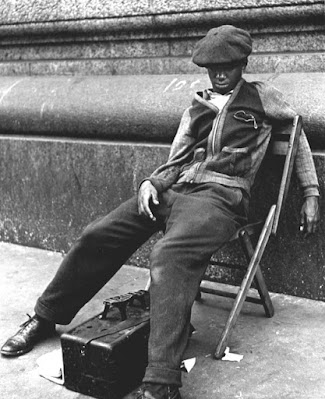Fred Stein was born on July 3, 1909 in Dresden, Germany. As a teenager he was deeply interested in politics and became an early anti-Nazi activist. He was a brilliant student, and went to Leipzig University, full of humanist ideals, to study law. He obtained a law degree in an impressively short time, but was denied admission to the German bar by the Nazi government for “racial and political reasons.” The threat of Fascism grew more and more dangerous and after the SS began making inquiries about him, Stein fled to Paris in 1933 with his new wife, Liselotte Salzburg, under the pretext of taking a honeymoon.
 |
| Old Man in Paris, 1936 |
In Paris they were in the center of a circle of expatriates, intellectuals and artists. In the midst of upheaval, gathering war, and personal penury, Stein began taking photographs. He was a pioneer of the small, hand-held camera, and with the Leica which he and his wife had purchased as a joint wedding present, he went into the streets to photograph scenes of life in Paris. He saw hope and beauty where most people would only see despair. He also became acquainted with and photographed some of the leading personalities of Europe.
 |
| Gerda Taro and Robert Capa, Cafe de Dome, Paris |
On May 7, 1941, the three boarded the S.S. Winnipeg, one of the last boats to leave France. They carried only the Leica and some negatives.
 |
| Paris in the 1930s |
New York was a vibrant center of culture, and Stein seized the opportunity. He met and photographed writers, artists, scientists, politicians, and philosophers whose work he knew through his extensive reading and study. This enabled him to engage them in conversation during portrait sessions. He continued his fascination with humanity, walking through the streets of New York, documenting life from Fifth Avenue to Harlem.
Stein died in 1967 at the age of 58. His portrait of Albert Einstein is his most famous picture: an iconic image of a great soul.






No comments:
Post a Comment